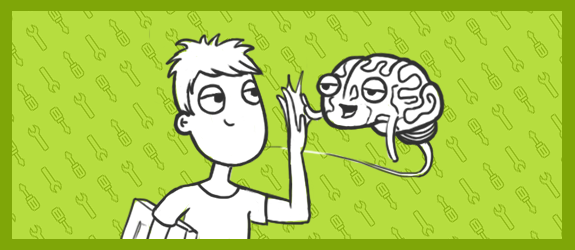We look at the logos with the brain
A small study of British scientists about how the brain perceives logos, evokes memories and shapes attitudes towards brands.

What happens in the brain when we look at the logo
First ... you see the logo.

')
The eye sends a signal to the primary visual cortex, and the brain recognizes the color and shape of the seen object.

These elements are grouped, and the object is identified at the level “this is a bird,” “this is an airplane.”

Then the brain compares the picture with the previous experience of meeting with it.

Based on your previous experience, “semantic attributes” are added, such as product name, brand attributes, associations, and your preferences.

And 400 milliseconds later, you remembered everything related to this logo and decided to go the other way.
How logos affect our thinking
In the brain there is no specific area responsible for the perception of logos. Premium brands and brands associated with consumer goods involve different parts of the brain.

The degree of familiarity with the logo also affects which area of the brain is activated when it encounters it. Famous brands use sites associated with positive emotions and promotions. While little-known brands activate neurons in the areas responsible for negative emotions.
In addition, the logos of the most beloved brands excite activity in the brain area responsible for the formation of self-esteem and self-perception.

Our attitude towards brands is similar to attitude towards people. Favorite brands even activate the same areas of the brain that are associated with friendship and other types of relationships.

Logos are also able to influence human behavior. Scientists conducted an experiment with a group of students and found out that students who often came across the Disney logo showed the best results in the honesty test.

The material is based on infographics from logomaker.com
Do not forget that most of the materials appear first in our public domain.


What happens in the brain when we look at the logo
First ... you see the logo.

')
The eye sends a signal to the primary visual cortex, and the brain recognizes the color and shape of the seen object.

These elements are grouped, and the object is identified at the level “this is a bird,” “this is an airplane.”

Then the brain compares the picture with the previous experience of meeting with it.

Based on your previous experience, “semantic attributes” are added, such as product name, brand attributes, associations, and your preferences.

And 400 milliseconds later, you remembered everything related to this logo and decided to go the other way.
How logos affect our thinking
In the brain there is no specific area responsible for the perception of logos. Premium brands and brands associated with consumer goods involve different parts of the brain.

The degree of familiarity with the logo also affects which area of the brain is activated when it encounters it. Famous brands use sites associated with positive emotions and promotions. While little-known brands activate neurons in the areas responsible for negative emotions.
In addition, the logos of the most beloved brands excite activity in the brain area responsible for the formation of self-esteem and self-perception.

Our attitude towards brands is similar to attitude towards people. Favorite brands even activate the same areas of the brain that are associated with friendship and other types of relationships.

Logos are also able to influence human behavior. Scientists conducted an experiment with a group of students and found out that students who often came across the Disney logo showed the best results in the honesty test.

The material is based on infographics from logomaker.com
Do not forget that most of the materials appear first in our public domain.

Source: https://habr.com/ru/post/294030/
All Articles